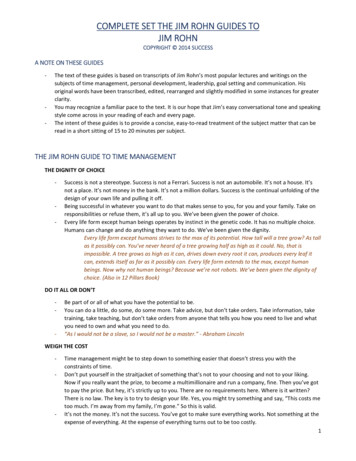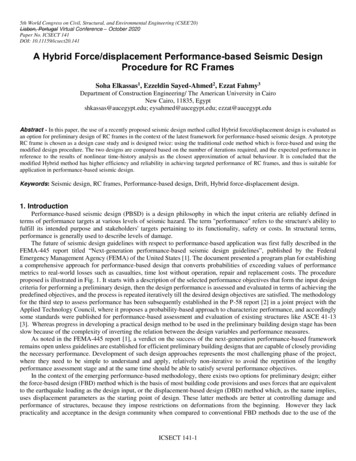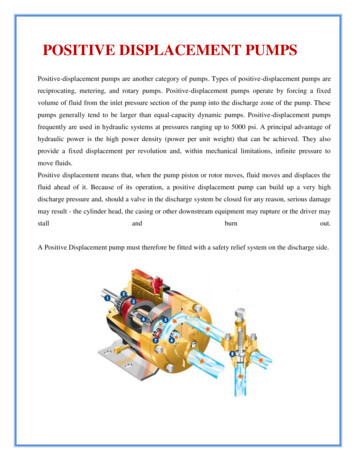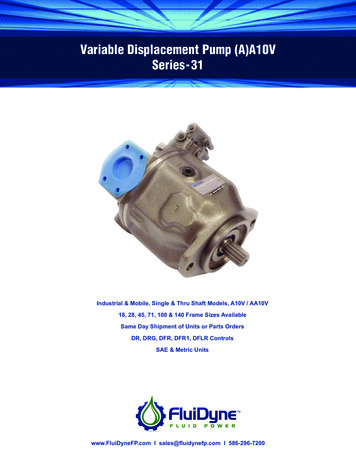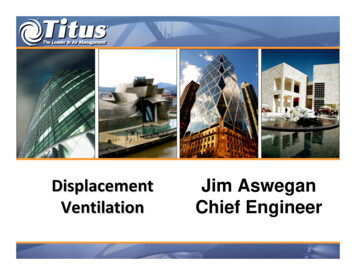
Transcription
DisplacementVentilationJim AsweganChief Engineer
Displacement Ventilation Systems Comfort & Contaminate Control DV Concepts & System Benefits Outlet Types and Air Patterns Example Space Layouts Displacement & LEED2
ASHRAE – 2011 Application Ch. 57Fully StratifiedDisplacementPartially MixedUnder Floor Air DistributionFully MixedG.R.D.
Fully Mixed Air Distribution Cold & (Hot) Supply Air 48‐58 F (85‐90 F) High Velocity Supply OutsideZoneOccupied Minimizes Temp. Variations in Space Uniform Contaminate Concentration4
Fully Mixed Air DistributionMixed Air DistributionMixed Contaminates5
Fully Stratified Air Distribution Cool Air Supply Only 60 ‐ 68 Air is Supplied Horizontally across the Floor atLow Velocity ( 70 fpm) Temperature Stratification from Floor toCeiling (Return) Contaminate Concentration reduced inOccupied Zone6
Fully Stratified Air Distribution7
Displacement VentilationBASIC CONCEPTS&SYSTEM BENEFITS8
Basic System Concepts Low Energy– ( 0.04 Ps) Air ChangeEffectiveness– (Std. 62.1, Ez 1.2) Quiet Operation– ( 25 NC)
Low Energy Higher equipment efficiency– Uses warmer supply air 65 F compared to 55 F– Energy consumption is often reduced by raisingdischarge temperature– Extended Economizer Cycle
HVAC System Benefits Heat sources outside the stratificationlayer are not considered in airflowcalculations– Lighting load is designed as “equipment load”,but not as “space load”– Effects cooling load capacity, but not airdistribution capacity
HVAC System Benefits Use 100% outside air overnight to cool– Reduced chiller capacity– Can be considered a thermal energy storagesystem qualifying the owner for utility rebates
Low Energy Lower horsepower fans– 0.04 in. pressure is required for proper diffuserperformance– Results in lower horsepower fans required FanEnergy Savings
Improved Ventilation ASHRAE Standard 62.1 ‐ Ventilation for AcceptableIndoor Air Quality Zone Air Distribution Effectiveness, Ez Overhead Cooling System 1.0 Displacement Ventilation 1.2 16.7% Less Fresh Air Required
Return Air Outlet located at ceilinglevel Allows heat from ceilinglights to be returned beforeit is able to mix withoccupied zone Reduced supply volumemeans higher returntemperatures
Humidity Issues A potential problem with warmer supply air temperatures ishigher humidity Supply system must reduce relative humidity to less than60% to meet IAQ concerns– Condenser water reheat, run‐around coils, or face & bypass– Use of a separate system to dry outside air or theuse of desiccant dehumidification If 55oF supply air is used for dehumidification, return air canbe mixed with supply air to achieve 65oF air
Perimeter Heating Perimeter heating can not be accomplishedwith traditional displacement ventilation Separate system required in mostapplications:––––––UFAD perimeter systemPerimeter fan powered systemsDucting of hot or reheated airBaseboard RadiationRadiant panelsDual Chamber Diffuser17
Dual Chamber DiffuserDual chamber plenumDual chamber diffuser Displacement cooling Mixed-air heating Actuated diverter (24V)Displacement diffuser – coolingLinear diffuser – heating18
Application Examples Good applications–––––––Room height 9.0 ftOpen Plan OfficesMeeting RoomsCasinosRestaurantsTheaters, & AuditoriumsSchools & Universities19
Displacement Ventilation Advantages– Smaller cooling power for desired roomtemperature in the occupied area– Improved air quality in occupied area– Longer periods of free cooling20
Application Examples Poor Applications– Room height 9 ft– Surplus heat is the main problem –air qualitynot– In combination with mixing systems– Office/rooms with cubicles– Spaces with heavy contaminants21
Displacement Ventilation Disadvantages– Risk of draft due to placement of the diffusers– Wall mounted devices often occupy large wallareas– Stratified air becomes uncomfortable whencooling load exceeds 30 Btu/hr‐ft2– Cannot heat with displacement ventilation22
Thermal Comfort ASHRAE Standard 55 – Thermal Environmental Conditionsfor Human Occupancy Maximum recommended Thf 5.4 F Avoid drafts by keeping Tes 36 F
Temperature Gradient Ceiling Height 9’‐14’ 50% Rule is applied 62 F – 72 F – 82 F10 F‐ 10 F(Displacement ventilation, REHVA)
Temperature Gradient Ceiling Height 14’ 33% Rule33%67% 65 F – 72 F – 86 F7 F ‐ 14 F(Displacement ventilation, REHVA)
Displacement VentilationTYPES OF OUTLETS&DISTRIBUTION PATTERNS26
Adjacent Zone27
Discharge Air Patterns28
Standard Air Patterns‐Adjusted Air Patterns29
Displacement VentilationSizes and ShapesAIR PATTERNS
Displacement DiffusersRectangular Mounts in wall 1–way pattern31
Displacement DiffusersRectangular Rectangular In wall, flush or floor mount32
Displacement DiffusersRectangular 3‐Way Rectangular In wall, flush or floor mount 3–way pattern33
Displacement DiffusersRectangular –Curved Face Flush or floor mount 3–way pattern34
Displacement DiffusersRectangular –“Stair Riser” Steps, Stair Risersapplications Great for auditoriums,concert, arena’s,and lecture halls35
Displacement DiffusersCircular Column or floor mount 360º discharge36
Displacement DiffusersSemi‐Circular 180º Sidewall or columnapplications 180º pattern37
Displacement DiffusersU – shaped Semi‐circular w straightsides 3–way pattern38
Displacement DiffusersCorner w/ CurvedFace Corner mountapplications 2–way pattern39
Displacement DiffusersCorner/Flat Face Corner mountapplications 2–way pattern40
Displacement VentilationEXAMPLE SPACE LAYOUTS41
Private Perimeter OfficePerimeter Wall42
Open Plan Interior Office43
Interior Break RoomRoundOutlets44
Perimeter Conference RoomOutside Wall45
Elementary School ClassroomPerimeter Wall46
ASHRAE Standards for LEED ASHRAE 62.1––––IEQ Prerequisite 1: Minimum IAQ PerformanceIEQ Credit 1: Outdoor Air Delivery MonitoringIEQ Credit 2: Increased VentilationIEQ Credit 6.2: Controllability of Systems: Thermal Comfort(for naturally ventilated spaces) ASHRAE Standard 55– IEQ Credit 6.2: Controllability of Systems: Thermal Comfort– IEQ Credit 7.1: Thermal Comfort: Design– IEQ Credit 7.2: Thermal Comfort: Verification
Displacement & LEED Optimize Energy Performance (EAc1) Minimum IAQ Performance (EQp1) Increased Ventilation (EQc2) Thermal Comfort: Design (EQc7.1)
Displacement Ventilation & LEED Minimum Energy Performance: EAp2 Optimize Energy Performance: EAc1 Minimum Indoor Air Quality Performance: IEQ p1 Increased Ventilation: IEQc2 Thermal Comfort Design: IEQc7.149
Minimum IAQ Performance (EQp1) Minimum IAQ per ASHRAE 62.1‐2007 EQ Prereq 1 – Required
Increased Ventilation (EQc2) Increase breathing zone outdoor air ventilationrates to all occupied spaces by at least 30%above the minimum rates required by ASHRAEStandard 62.1‐2007 as determined by EQ Prereq.1 Submit – Narrative describing the project’sventilation system, including fresh air intakevolume for each zone and confirmation thatoutdoor air exceeds ASHRAE 62.1 by 30% EQ Credit 2 ‐ 1 Point
Thermal Comfort (EQc7)Design Comply with ASHRAE Standard 55‐2004 Submit ‐ Narrative detailing establishedcomfort criteria per ASHRAE Standard 55‐2004, the desired quality and occupantsatisfaction with building performance, andsupporting documentation showing thesystem design meets these criteria EQ Credit 7.1 ‐ 1 Point
Publications HVAC Applications Handbook, Chapter 57 (ASHRAE, 2011) Fundamentals Handbook, Chapter 20 (ASHRAE, 2009) System Performance Evaluation and Guidelines for DisplacementVentilation (ASHRAE, 2003) Displacement Ventilation in Non‐Industrial Premises (REHVA,2002)
Thank you!Questions?54
ASHRAE Standards for LEED ASHRAE 62.1 – IEQ Prerequisite 1: Minimum IAQ Performance – IEQ Credit 1: Outdoor Air Delivery Monitoring – IEQ Credit 2: Increased Ventilation – IEQ Credit 6.2: Controllability of Systems: Thermal Comfort (for naturally ventilated spaces) ASHRAE Standard 55
